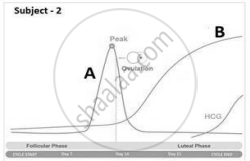Advertisements
Advertisements
प्रश्न
During the reproductive cycle of a human female, when, where and how does a placenta develop? What is the function of placenta during pregnancy and embryo development?
उत्तर
During the reproductive cycle of human female, placenta develops after the implantation of zygote in the uterus.
1) Nutrition : It helps to transport nutrients from mother's blood to foetus for its development.
2) Respiration: It provides oxygen to the foetus and take CO2 away from the foetus.
3) Excretion: It helps in the removal of waste products from the foetus and transfers them to mother's blood.
4) Immunity: It provides immunity to the foetus. Antibodies developed in mother's blood passes onto the foetus through the placenta.
5) Storage: It stores some fats, glycogen and iron.
6) Secretion of hormones: It secretes many hormones like oestrogen, progesterone, gonadotropin and placental lactogen.
APPEARS IN
संबंधित प्रश्न
When and where do chorionic villi appear in humans?
Comment on the role of placenta as an endocrine gland.
Gonads develop from embryonic ______.
Which of the following hormones is not a secretory product of human placenta?
Relaxin is the hormone secreted by the placenta.
To answer the question, study the graphs below for Subjects 1 and 2 showing different levels of certain hormones.


Subject 2 has a higher level of hormone B, which is ______
Read the following and answer from given below:
Cleavage is the series of rapid mitotic divisions in the zygote and forms blastula. The 2, 4, 8, 16 daughter cells are called blastomeres. An embryo with 64 blastomeres is known as a blastocyst and has a blastocoel cavity. Blastocyst gets implanted in the uterine wall and leads to pregnancy.
The correct sequence of various structures formed during embryonic development is ______
The secondary sexual characters develop in females because:
Name the type of antibody that can be transferred through the placenta.
The diagram given below represents a specific stage of human embryonic development. Identify the stage.

